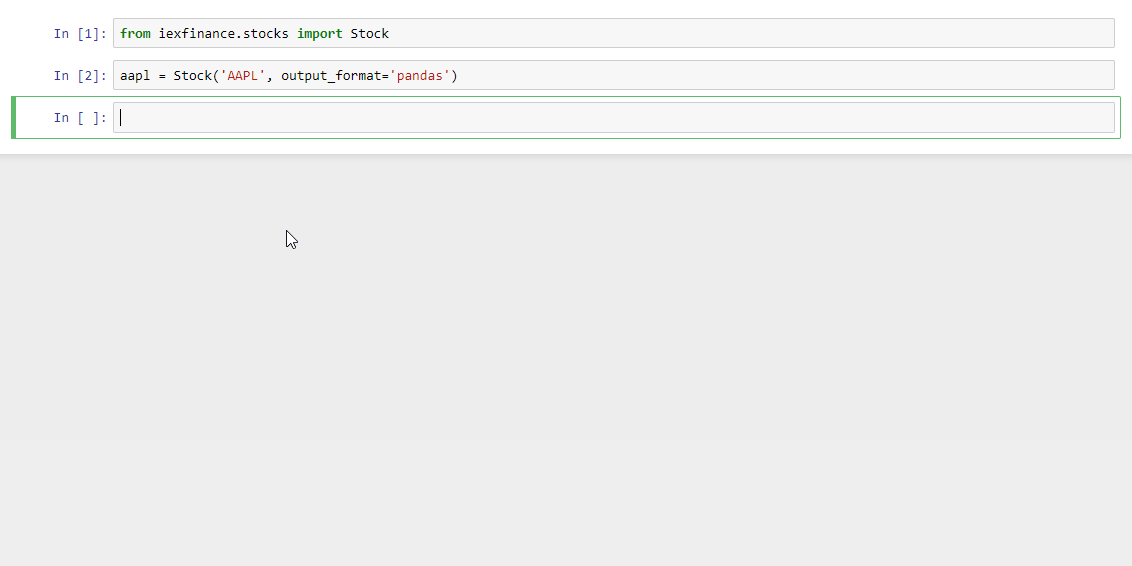
Python SDK for IEX Cloud. Architecture mirrors that of the IEX Cloud API (and its documentation).
An easy-to-use toolkit to obtain data for Stocks, ETFs, Mutual Funds, Forex/Currencies, Options, Commodities, Bonds, and Cryptocurrencies:
- Real-time and delayed quotes
- Historical data (daily and minutely)
- Financial statements (Balance Sheet, Income Statement, Cash Flow)
- End of Day Options Prices
- Institutional and Fund ownership
- Analyst estimates, Price targets
- Corporate actions (Dividends, Splits)
- Sector performance
- Market analysis (gainers, losers, volume, etc.)
- IEX market data & statistics (IEX supported/listed symbols, volume, etc)
- Social Sentiment and CEO Compensation
Stable documentation is hosted on github.io.
Development documentation is also available for the latest changes in master.
From PyPI with pip (latest stable release):
$ pip3 install iexfinance
From development repository (dev version):
$ git clone https://github.com/addisonlynch/iexfinance.git
$ cd iexfinance
$ python3 setup.py installAn IEX Cloud account is required to acecss the IEX Cloud API. Various plans are availalbe, free, paid, and pay-as-you-go.
Your IEX Cloud (secret) authentication token can be passed to any function or at the instantiation of a Stock object.
The easiest way to store a token is in the IEX_TOKEN environment variable.
The authentication token can also be passed to any function call:
from iexfinance.refdata import get_symbols
get_symbols(token="<YOUR-TOKEN>")or at the instantiation of a Stock object:
from iexfinance.stocks import Stock
a = Stock("AAPL", token="<YOUR-TOKEN>")
a.get_quote()iexfinance is designed to mirror the structure of the IEX Cloud API. The
following IEX Cloud endpoint groups are mapped to their respective
iexfinance modules:
The most commonly-used endpoints are the Stocks endpoints, which allow access to various information regarding equities, including quotes, historical prices, dividends, and much more.
The Stock object
provides access to most endpoints, and can be instantiated with a symbol or
list of symbols:
from iexfinance.stocks import Stock
aapl = Stock("AAPL")
aapl.get_balance_sheet()The rest of the package is designed as a 1:1 mirror. For example, using the
Alternative Data endpoint
group, obtain the Social Sentiment endpoint with
iexfinance.altdata.get_social_sentiment:
from iexfinance.altdata import get_social_sentiment
get_social_sentiment("AAPL")The iex-examples repository provides a number of detailed examples of iexfinance usage. Basic examples are also provided below.
To obtain real-time quotes for one or more symbols, use the get_price
method of the Stock object:
from iexfinance.stocks import Stock
tsla = Stock('TSLA')
tsla.get_price()or for multiple symbols, use a list or list-like object (Tuple, Pandas Series, etc.):
batch = Stock(["TSLA", "AAPL"])
batch.get_price()It's possible to obtain historical data using get_historical_data and
get_historical_intraday.
To obtain daily historical price data for one or more symbols, use the
get_historical_data function. This will return a daily time-series of the ticker
requested over the desired date range (start and end passed as
datetime.datetime objects):
from datetime import datetime
from iexfinance.stocks import get_historical_data
start = datetime(2017, 1, 1)
end = datetime(2018, 1, 1)
df = get_historical_data("TSLA", start, end)To obtain daily closing prices only (reduces message count), set
close_only=True:
df = get_historical_data("TSLA", "20190617", close_only=True)For Pandas DataFrame output formatting, pass output_format:
df = get_historical_data("TSLA", start, end, output_format='pandas')It's really simple to plot this data, using matplotlib:
import matplotlib.pyplot as plt
df.plot()
plt.show()To obtain historical intraday data, use get_historical_intraday as follows.
Pass an optional date to specify a date within three months prior to the
current day (default is current date):
from datetime import datetime
from iexfinance.stocks import get_historical_intraday
date = datetime(2018, 11, 27)
get_historical_intraday("AAPL", date)or for a Pandas Dataframe indexed by each minute:
get_historical_intraday("AAPL", output_format='pandas')from iexfinance.stocks import Stock
aapl = Stock("AAPL")
aapl.get_balance_sheet()aapl.get_income_statement()aapl.get_cash_flow()from iexfinance.stocks import Stock
aapl = Stock("AAPL")
aapl.get_estimates()aapl.get_price_target()from iexfinance.altdata import get_social_sentiment
get_social_sentiment("AAPL")from iexfinance.altdata import get_ceo_compensation
get_ceo_compensation("AAPL")from iexfinance.stocks import Stock
aapl = Stock("AAPL")
# Fund ownership
aapl.get_fund_ownership()
# Institutional ownership
aapl.get_institutional_ownership()List of Symbols IEX supports for API calls
from iexfinance.refdata import get_symbols
get_symbols()List of Symbols IEX supports for trading
from iexfinance.refdata import get_iex_symbols
get_iex_symbols()from iexfinance.account import get_usage
get_usage(quota_type='messages')from iexfinance.account import get_api_status
get_api_status()By default, iexfinance returns data for most endpoints in a pandas DataFrame.
Selecting json as the output format returns data formatted exactly as received from
the IEX Endpoint. Configuring iexfinance's output format can be done in two ways:
For persistent configuration of a specified output format, use the environment
variable IEX_OUTPUT_FORMAT. This value will be overridden by the
output_format argument if it is passed.
Type the following command into your terminal:
$ export IEX_OUTPUT_FORMAT=pandasSee here for instructions on setting environment variables in Windows operating systems.
Pass output_format as an argument to any function call:
from iexfinance.refdata import get_symbols
get_symbols(output_format='pandas').head()or at the instantiation of a Stock object:
from iexfinance.stocks import Stock
aapl = Stock("AAPL", output_format='pandas')
aapl.get_quote().head()Email: ahlshop@gmail.com
Twitter: alynchfc
Copyright © 2020 Addison Lynch
See LICENSE for details
